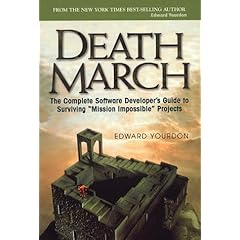For the use of this term in the software development industry, see death march (software development).
For the death marches of Jews from Nazi concentration camps, see Death marches (Holocaust).
A death march is a long-distance march in extremely harsh conditions with disregard for the life and health of the victims, usually prisoners or refugees. The idea behind the marches was to force prisoners to walk, at gunpoint, without food, water, shelter, or amenities; those who couldn't keep up were often shot.
 During the Holocaust
During the HolocaustThe term has been applied to similar events in other places.
In Asia, the Japanese forces also conducted death marches, including the infamous Bataan Death March and Sandakan Death Marches.
During the 1915 Armenian Genocide, thousands of men, women and children were forced into death marches through the desert of Deir ez-Zor where most of them perished, leaving few survivors. Today there is a memorial in Deir ez-Zor for the marchers.
Earlier in American history (1838), the Cherokee nation had to march westward towards Oklahoma. This became known as the Trail of Tears where an estimated 4,000 men, women, and children died during relocation.
In 1835, Alexander Herzen encountered emaciated cantonists, Jewish boys (some as young as 8 years old) conscripted to the Imperial Russian army. Herzen was being convoyed to his exile at Vyatka, the cantonists were marched to Kazan and their (sympathetic) officer complained that a third had already died.
The 1975 forced evacuation of Phnom Penh in Cambodia under the Khmer Rouge.
No comments:
Post a Comment